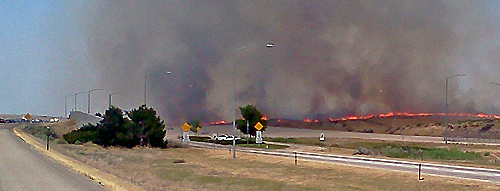

D-3 crews help reduce risks of I-84 roadside fires
Fire agencies spent millions of dollars on firefighting efforts in Idaho last year. This spring, District 3 is doing its part to prevent similar expenditures and the economic impacts to motorists caused by fire suppression activities near highways.
 ITD is spraying weeds and grass along a 64-mile stretch of interstate from Boise to Glenns Ferry to reduce roadside vegetation (consumable fuel for fires) up to eight feet beyond the highway’s edge. The spraying is expected to cost about $30,000 – a far cry from the total spent to fight fires last year along Idaho roads.
ITD is spraying weeds and grass along a 64-mile stretch of interstate from Boise to Glenns Ferry to reduce roadside vegetation (consumable fuel for fires) up to eight feet beyond the highway’s edge. The spraying is expected to cost about $30,000 – a far cry from the total spent to fight fires last year along Idaho roads.
According to the Bureau of Land Management’s (BLM) Boise District Resource Advisory Council, 16 fires started along I-84 between mileposts 60 and 110. The fires burned more than 5,480 acres at a cost of $282,000 to BLM; other fire agencies also incurred costs to extinguish roadside blazes. Those costs are for suppression only; lost habitat, lost grazing land, damage to resources and lost income added substantially to the overall economic impact of the fires.
Tom Points, D-3 operations manager, said a review of the fire data shows that most fires started within two-to-three feet of the pavement edge. Accordingly, ITD is undertaking the following measures:
-
Begin a three-year cycle of grading the shoulder areas along I-84 to remove the buildup of grasses as a source for fuel for the fires.
-
Mow farther off the edge using an 18-foot-wide strip (instead of 10- or 12-feet wide)
-
Adopt a bare-ground treatment eight feet from the edge of pavement for fires. That strategy was introduced after consulting with the Oregon Department of Transportation, which has a similar policy in Eastern Oregon. The intent of the policy is to keep the highway shoulders free of vegetation through chemical treatment.
ITD also worked with the BLM the past five years to establish low-growing, fire-resistant grasses along the I-84 corridor.
Published 3-29-13